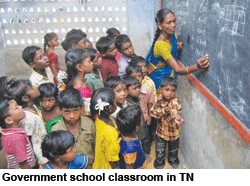Tamil Nadu: Damning indictment
Although the southern littoral state of Tamil Nadu (pop: 72.1 million) prides itself on providing easy access to public education with officials claiming 99.4 percent enrolment in government primaries, the quality of education dispensed is a subject they prefer to gloss over.
A sample survey conducted last December by the Sama Kalvi Iyakkam-Tamil Nadu (SKI-TN) — a people’s movement established in 1998 to ensure equity in education and promote the common school system — reveals that a high percentage of the 53,000 government schools in Tamil Nadu lack basic infrastructure facilities which prompts 60 percent of children — especially girl children — to drop out before entering secondary school.
 The survey which studied 180 elementary (primary and upper primary), middle, high and higher secondary government schools in Chennai, Virudhunagar, Ramanathapuram, Pudukottai, Salem, Dharmapuri, Vellore and Karur districts, found that two schools in Ramanathapuram and Vellore districts had only one student each, 20 schools in rural Salem didn’t have functional toilets, and a school in Tiruvannamalai district had only two teachers for 187 children. At the Karipatti Government High School, Salem, which has an enrolment of 309 mostly Dalit children, classes are held under a tree or in temporary shelters to make way for widening of a highway nearby. The survey also notes that 60 percent of girl children dropped out of upper primaries because of lack of toilets, while others developed skin rashes as a result of sitting on the ground for long periods. The survey ascribes high dropout rates to a mix of factors including lack of toilets, drinking water facilities and walking long distances to school — all of which violate the norms prescribed by the landmark Right to Free & Compulsory Education Act, 2009.
The survey which studied 180 elementary (primary and upper primary), middle, high and higher secondary government schools in Chennai, Virudhunagar, Ramanathapuram, Pudukottai, Salem, Dharmapuri, Vellore and Karur districts, found that two schools in Ramanathapuram and Vellore districts had only one student each, 20 schools in rural Salem didn’t have functional toilets, and a school in Tiruvannamalai district had only two teachers for 187 children. At the Karipatti Government High School, Salem, which has an enrolment of 309 mostly Dalit children, classes are held under a tree or in temporary shelters to make way for widening of a highway nearby. The survey also notes that 60 percent of girl children dropped out of upper primaries because of lack of toilets, while others developed skin rashes as a result of sitting on the ground for long periods. The survey ascribes high dropout rates to a mix of factors including lack of toilets, drinking water facilities and walking long distances to school — all of which violate the norms prescribed by the landmark Right to Free & Compulsory Education Act, 2009.
According to SKI-TN spokespersons, although the survey is highly critical of under-investment in Tamil Nadu’s government schools, the objective of the study is constructive criticism to reduce attrition rates in government schools and prevent students’ flight to fees-levying private primary-secondaries. It is also part of SKI-TN’s ongoing campaign to ensure implementation of the RTE Act. “We want government to build infrastructure to retain students instead of merging or closing down schools, and to promote neighbourhood schools,’’ says Chella Selvakumar, general secretary of SKI-TN.
While several organisations such as the SKI-TN have been crusading for improved infrastructure in government schools, they seem to be unaware that given the apathy of politicians to nuts-and-bolts issues in education, they are flogging a dead horse. Despite s. 19 and Schedule of the RTE Act detailing infrastructure and teacher-pupil norms, little progress has been made in upgrading government primaries which grudgingly host 70 percent of in-school children. These deficiencies have also severely hit learning outcomes.
According to the Annual Status of Education Report (ASER) 2012 released this February, although Tamil Nadu bests all other states in terms of enrolment, learning outcomes in government primaries are very poor. Only 43.4 percent of class I children can recognise Tamil alphabets, and 43.6 percent of class II children can read simple Tamil words with a mere 17.4 percent of class III students able to manage simple sums.
Pathetic infrastructure, adverse teacher-pupil ratios and chronic teacher absenteeism is driving a growing percentage of households to send their children to fees-levying private schools offering prized English-medium education. ASER 2012 reveals that enrolment in private schools in Tamil Nadu has risen from 15.7 percent in 2007 to 30.2 percent in 2012 while in the same period in government schools, it has dropped from 84.3 to 69.8 percent.
Meanwhile, despite widespread infrastructure and teacher inadequacies, in fulfillment of its pre-election promise, the AIADMK government is proceeding with distributing 6.8 million free-of-charge laptops to students in government-aided higher secondary schools and colleges over the next five years under its whopping Rs.1,020 crore welfare scheme. Unsurprisingly, the scheme has already run into trouble with many of the 9.12 lakh recipients of the first year selling their laptops in the open market at throwaway prices, much to the consternation of the suppliers whose credibility is at stake.
With the state government totally out of step with the actual needs and priorities of the primary and secondary education sectors, the exodus to private schools is gathering momentum. With bottom-of-the-pyramid (BoP) parents too ignorant and poor to protest relentless deterioration of the public education system, and middle class children safely enroled in high performing private schools, children of BoP households are doomed to remain hewers of wood and drawers of water.
Hemalatha Raghupathi (Chennai)















Add comment